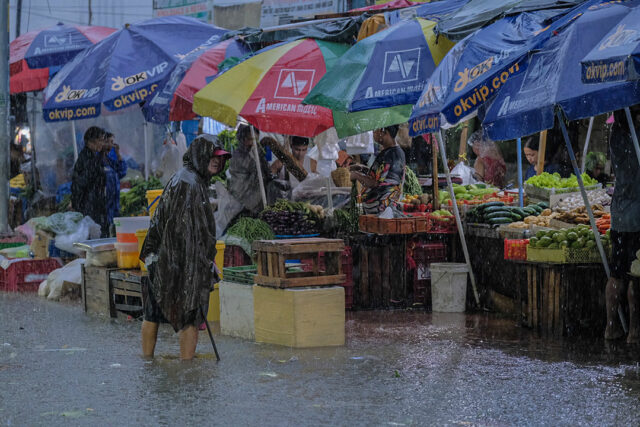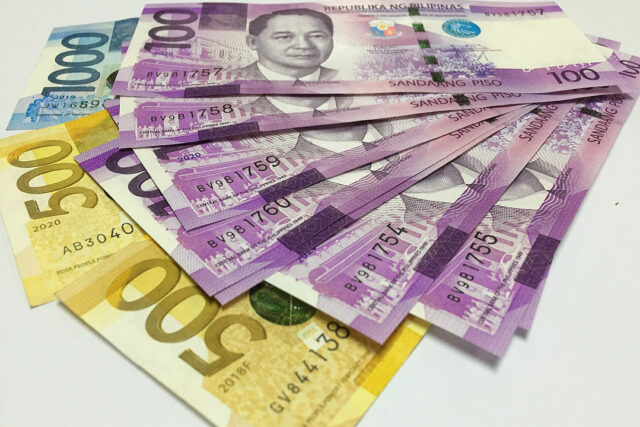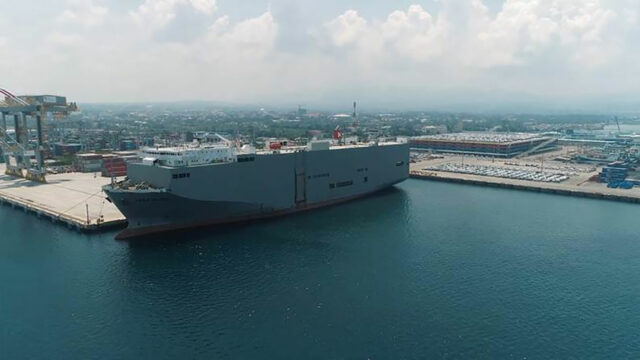By Luisa Maria Jacinta C. Jocson, Reporter
HEADLINE INFLATION likely eased in August and returned to within the central bank’s 2-4% target band amid a drop in prices of rice and fuel, analysts said.
A BusinessWorld poll of 15 analysts yielded a median estimate of 3.7% for the consumer price index (CPI) in August. This is within the 3.2-4% forecast of the Bangko Sentral ng Pilipinas (BSP) for the month.
August inflation would also be slower than the nine-month high of 4.4% in July and the 5.3% print in the same month a year ago.

The Philippine Statistics Authority (PSA) is set to release August inflation data on Thursday (Sept. 5).
“Higher electricity rates and higher prices for agricultural commodities, owing to unfavorable weather conditions, are the primary sources of upward price pressures for the month,” the BSP said.
“These factors are expected to be offset by lower domestic oil prices as well as lower rice, fish, and meat prices along with the peso appreciation,” the BSP said.
Union Bank of the Philippines, Inc. Chief Economist Ruben Carlo O. Asuncion said August inflation likely slowed mainly due to the decline in rice prices.
“We expect the lower tariff rates for rice to be a key downward pressure on prices,” Sarah Tan, an economist from Moody’s Analytics, said in an e-mail.
Rice inflation eased to 20.9% in July from 22.5% in June, marking the fourth straight month of slower rice inflation. Rice typically accounts for almost half of overall inflation.
“August last year was the time when rice prices started to climb due to a global supply crunch. But due to lower tariff rates in 2024, rice prices have remained more or less stable, leading to headline CPI (consumer price index) dropping significantly on a year-on-year basis,” HSBC economist for ASEAN (Association of Southeast Asian Nations) Aris D. Dacanay said.
In June, President Ferdinand R. Marcos, Jr. slashed the tariff on rice imports to 15% from 35% until 2028 in an effort to tame rice prices.
Slower inflation “may primarily have been driven by food basket inflation, attributed to weak rice imports and heavy rainfall disrupting local food production,” Security Bank Corp. Chief Economist Robert Dan J. Roces said.
“These factors have likely led to sustained growth in domestic food prices, particularly affecting rice,” he added.
Meanwhile, analysts also noted that slower transport inflation may have contributed to inflation settling within BSP’s 2-4% target.
“The main drag from the 4.4% headline rate in July should come from a big fall in transportation inflation, going by the material drop in pump prices over the last few weeks,” Pantheon Chief Emerging Asia Economist Miguel Chanco said.
“Adding to the disinflationary impulse is the significant reduction in fuel prices throughout the month,” Mr. Dacanay said.
In August alone, pump price adjustments stood at a net decrease of P2.70 per liter for gasoline, P2.80 per liter for diesel, and P3.70 per liter for kerosene.
“We estimated a double-digit annual growth drop of 10% in retail petroleum prices, and diesel prices have the largest sales volume that could partially offset the estimated electricity rate hike of 6.7% year on year for August,” Mr. Asuncion said.
On the other hand, analysts also noted potential upside risks to inflation in August, such as the impact of Typhoon Carina and the southwest monsoon that hit Luzon in late July.
“The impact from Typhoon Carina that struck in July is expected to show up in August’s print in terms of higher prices for agricultural produce like vegetables,” Ms. Tan said.
Latest data from the Agriculture department showed that agricultural damage from Typhoon Carina and the southwest monsoon stood at P4.73 billion. Rice was the most affected crop, accounting for 22.9% or P1.08 billion of the overall damage.
“We believe that favorable base effects, especially for rice, will outweigh the lingering adverse impact of Tropical Depression Butchoy and Typhoon Carina on overall food prices,” Philippine National Bank economist Alvin Joseph A. Arogo said.
Also, Ms. Tan said utilities inflation likely accelerated in August as Manila Electric Co. (Meralco) raised electricity prices.
In August, Meralco hiked rates by P0.0327 per kilowatt-hour (kWh), bringing the overall rate of P11.6339 per kWh for a typical household from the previous month’s P11.6012 per kWh.
ROOM FOR MORE RATE CUTS?
With inflation likely in a downtrend, analysts expect that the central bank will be able to continue its easing cycle.
“Should the inflation print in August and the next couple of months confirm that July’s spike was just a blip, and that inflation is indeed in a downtrend as the BSP expects, this will give BSP confidence to deliver another rate cut in the fourth quarter,” Ms. Tan said.
In August, the Monetary Board reduced the target reverse repurchase (RRP) rate by 25 basis points (bps) to 6.25% from the over 17-year high of 6.5%.
This was the first time the BSP cut rates in nearly four years or since November 2020.
The BSP could further reduce rates in order to match any US Federal Reserve rate cuts, Rizal Commercial Banking Corp. Chief Economist Michael L. Ricafort said.
“We think this will support the BSP’s rate-cutting cycle and we expect at least another 25-bp cut in the fourth quarter. If the Fed cuts aggressively at 50 bps, the BSP is likely to match this rate cut,” Patrick M. Ella, economist at Sun Life Investment Management and Trust Corp., said.
Money markets are confidently pricing the Fed’s first 25-bp cut of this cycle at its September meeting, with a 33% chance of a jumbo 50-bp reduction, Reuters reported.
“Sustained deceleration in August could translate to one more RRP cut and a possible 0.5% to 1% reduction in the RRR before the year ends,” Bank of the Philippine Islands Lead Economist Emilio S. Neri, Jr. said.
BSP Governor Eli M. Remolona, Jr. earlier said that they can deliver another 25-bp rate cut in the fourth quarter.
For his part, Mr. Dacanay expects to see the policy rate at 6% by end-2024.
“We also expect core CPI to continue its gradual moderation, many thanks to the central bank’s tight grip on monetary policy, providing the BSP room to cut policy rates by 25 bps to 6% by yearend,” he added.
On the other hand, De La Salle University economist Mitzie Irene P. Conchada said there are some risks that could delay the BSP’s continued policy easing.
“External factors such as calamities and external events could affect inflation and result in an upward trend towards the end of the year. Furthermore, I think that the BSP will keep its interest rates in its next policy meeting,” she said.
The BSP’s last two policy meetings of the year are scheduled on Oct. 17 and Dec. 19.





 Attendees will have the opportunity to learn, interact, and collaborate through five focused tracks: ‘From Ecommerce to Digitally Enabled Commerce’ (Ecommerce), ‘From IMC to Customer-Centric Campaigns’ (Brand Building in AI Age), ‘From Digital Transformation to Business Evolution’ (Digital Transformation), ‘From Data Driven to Insight Driven’ (Analytics RPA and Data Science), and ‘From I to AI’ (Innovation Labs on AI). These tracks, along with various practical and immersive activities, aim to provide a road map for leveraging rapid digital changes, equipping attendees with tools and insights for digital agility and continuous learning.
Attendees will have the opportunity to learn, interact, and collaborate through five focused tracks: ‘From Ecommerce to Digitally Enabled Commerce’ (Ecommerce), ‘From IMC to Customer-Centric Campaigns’ (Brand Building in AI Age), ‘From Digital Transformation to Business Evolution’ (Digital Transformation), ‘From Data Driven to Insight Driven’ (Analytics RPA and Data Science), and ‘From I to AI’ (Innovation Labs on AI). These tracks, along with various practical and immersive activities, aim to provide a road map for leveraging rapid digital changes, equipping attendees with tools and insights for digital agility and continuous learning. Since its first iteration in 2016, DigiCon has consistently been a pivotal gathering for the luminaries of Philippine marketing, advertising, and digital landscapes.
Since its first iteration in 2016, DigiCon has consistently been a pivotal gathering for the luminaries of Philippine marketing, advertising, and digital landscapes.








